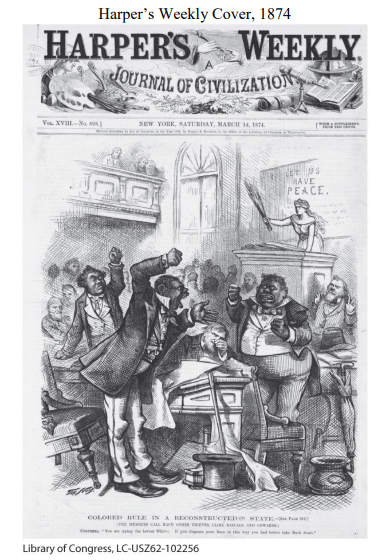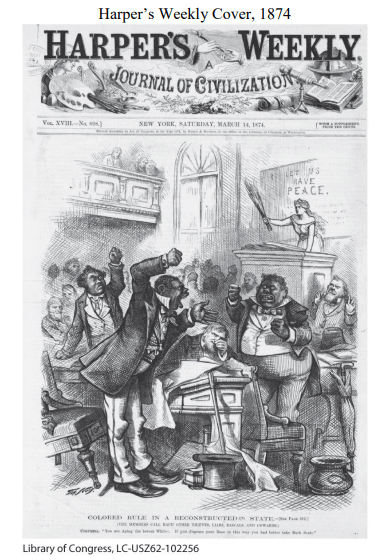This term refers to the 19th-century belief that the expansion of the United States across the North American continent was both justified and inevitable.
Manifest Destiny
An 1846 proposal to prohibit slavery in any land gained in the Mexican War.
Wilmot Proviso
Also known as the Know-Nothing Party, a prominent United States political party during the late 1840s and the early 1850s that was anti-Catholic and nativist.
American Party
Term used during the Civil War to describe escaped slaves who fled to Union lines for protection.
Contraband
A significant 1863 battle in the Civil War, the Union victory here marked a turning point in the war.
Battle of Gettysburg
A government agency founded during Reconstruction to help former slaves.
Freedmen’s Bureau
A derogatory term for Southern whites who supported Reconstruction following the Civil War.
Scalawags
A financial crisis that triggered a depression in Europe and North America that lasted from 1873 until 1879, and even longer in some countries.
Panic of 1873
This was a conflict fought between the United States and Mexico from 1846 to 1848, resulting in the acquisition of significant territory by the U.S., including California, Arizona, New Mexico, and parts of other southwestern states.
Mexican-American War
A series of laws passed to maintain the balance of power between slave and free states.
Compromise of 1850
A series of violent civil confrontations in Kansas Territory between 1854 and 1861 which emerged from a political and ideological debate over the legality of slavery.
Bleeding Kansas
The first major battle of the Civil War, fought in Virginia in 1861.
Battle of Bull Run (First Manassas)
A crucial 1863 Union victory during the Civil War that gave the Union control of the Mississippi River.
Siege of Vicksburg
A faction of American politicians that led Reconstruction after the Civil War.
Radical Republicans
A derogatory term applied by former Confederates to Northerners who moved to the South during Reconstruction, between 1865 and 1877.
Carpetbagger
A United States federal law enacted during the Reconstruction Era to protect African Americans from discrimination in public accommodations and jury service.
Civil Rights Act of 1875
The 1848 treaty that ended the Mexican-American War, ceding a significant portion of Mexican territory to the United States.
Treaty of Guadalupe Hidalgo
Law that required all citizens to help catch runaway slaves.
Fugitive Slave Act of 1850
An unsuccessful 1860 proposal aimed at resolving the secession crisis by guaranteeing the permanent existence of slavery in the slave states.
Crittenden Plan
An executive order issued by Abraham Lincoln in 1862 that declared slaves in Confederate-held territory to be free.
Emancipation Proclamation
A devastating total war military campaign, led by Union General Sherman, that involved marching 60,000 Union troops through Georgia from Atlanta to Savannah in 1864.
Sherman’s March to the Sea
Laws that divided the South into five districts, each under the control of a Union general, in the aftermath of the Civil War.
Military Reconstruction Acts
An African American who migrated from states along the Mississippi River to Kansas in the late nineteenth century, as part of the Exoduster Movement or Exodus of 1879.
Exoduster
An unwritten deal that settled the intensely disputed 1876 U.S. presidential election, pulled federal troops out of state politics in the South, and ended the Reconstruction Era.
Compromise of 1877
The period starting in 1848 when gold was discovered in California, leading to a massive influx of people seeking wealth and economic opportunities.
The period starting in 1848 when gold was discovered in California, leading to a massive influx of people seeking wealth and economic opportunities.
A network of secret routes and safe houses used by enslaved people to escape into free states and Canada.
Underground Railroad
An 1859 attempt by abolitionist John Brown to initiate an armed slave revolt by taking over a United States arsenal at Harpers Ferry, Virginia.
John Brown's Raid
An 1863 law that required all men between 20 and 45 to register for the draft, leading to riots in New York City.
Enrollment Act
A military strategy of targeting civilian infrastructure and resources to disrupt an enemy's economy and morale.
Total War
An 1867 law that was intended to restrict the power of the President of the United States to remove certain office-holders without the Senate's approval.
Tenure of Office Act
A political coalition in the South during the Reconstruction era, who sought to oust the Radical Republican coalition of freedmen, carpetbaggers and scalawags.
Redeemers

The image is a response to which of the following developments in the United States?
a. Republican efforts to reorder race relations in the defeated South
b. The South’s restriction of political opportunities and other leadership roles for freedpeople
c. The abolitionist movement’s willingness to use violence to achieve its goals
d. The support for racial segregation in the Plessy v. Ferguson decision
a. Republican efforts to reorder race relations in the defeated South
This is a postwar image; as such slavery has been outlawed for nearly a decade, so actions of the abolitionist movement influencing this image are totally false. Also, the Plessy decision calling for racial segregation will not take place for another twenty years, rendering that choice incorrect as well. The best answer is that Republican efforts to reorder race relations in the South generated southern resistance and backlash, as evidenced by the racial characterizations in the image.
A political party in the 1840s that opposed the expansion of slavery into newly acquired territories, contributing to growing sectional tensions
Liberty Party
A secret 1854 document proposing the U.S. buy Cuba from Spain to make it a new slave state.
Ostend Manifesto
A series of seven debates in 1858 between Abraham Lincoln and Stephen Douglas on the issue of slavery.
Lincoln-Douglas Debates
Northern Democrats who opposed the Civil War and wanted a negotiated peace with the South.
Copperheads
An 1864 attack in which Colorado Territory militia killed more than 150 Cheyenne and Arapaho people, mostly women, children, and the elderly.
Sand Creek Massacre
An organization formed during the American Civil War to advocate for equal rights for all, regardless of race or gender.
American Equal Rights Association
A series of four acts passed by Republican Reconstruction supporters in the Congress between May 31, 1870, and March 1, 1875, to protect the constitutional rights guaranteed to blacks by the Fourteenth and Fifteenth Amendments.
Force Acts

An individual who agreed with the artist’s perspective as portrayed in the cartoon would express the greatest support for
a. placing limits on African American rights.
b. maintaining full legal equality for African Americans.
c. utilizing systems of patronage at all levels of government.
d. a moral obligation of wealthy people to help the less fortunate in society.
a. placing limits on African American rights.
Far from advocating for equality for African Americans, the artist portrays them brutishly and clownishly, implying that they have been given a station and position and power that they were unprepared to exercise. Agreeing with the artist would involve placing limits on African Americans. The obligation of those of wealth to assist the less fortunate is in no way relevant to the discussion.